43rd Mozilla version Firefox on the Stable and Beta channels blocks the installation of unsigned extensions.
To disable signature verification for extensions, you can change the settings:
- in the address bar, enter about:config and go to the page;
- click the "I promise I'll be careful" button on the warning page;
- in the "Search" field, enter the name of the parameter: xpinstall.signatures.require ;
- find it in the list and double click on it so that the value "true" changes to "false"
Disabling Signature Verification Through Custom Scripts
In Firefox 48 for the Stable and Beta channels, Mozilla deprecated the xpinstall.signatures.require setting. On the Dev, Nightly, and ESR channels, as well as the Firefox Unbranded build, which is stable version, the option is still available.
All extensions provided in the main Mozilla repository are signed differently from extensions from third-party sources.
Today, there are many app-provided extensions on the Github and Bitbucket development platforms, as well as older extensions that are no longer maintained by developers and cannot be signed. All of them cannot be installed in Firefox Stable or Beta by standard means.
This method involves creating two files in the main directory where Firefox is launched from.
1. config.js file
1.1. Create text file;
1.2. Paste the code into it:
//
try(
Components.utils.import("resource://gre/modules/addons/XPIProvider.jsm", ())
.eval("SIGNED_TYPES.clear()");
}
catch(ex)()
1.3. Rename it to "config.js". Make sure it's called config.js and not config.js.txt;
1.4. Move it to the directory where Firefox is installed:
- Windows-" C:\Program Files\ Mozilla Firefox\ " or " C:\Program Files (x86)\Mozilla Firefox\";
- linux-" /usr/lib/firefox-<версия> " or " /usr/lib64/firefox-<версия> ";
- OSX - "/Applications/Firefox.app/".
These are directories Firefox installations default. They may differ depending on your settings during installation or Linux distribution. It is important that the file is in the root directory of the program.
2. config-prefs.js file
2.1. Create a second text file;
2.2. Paste the code into it:
pref("general.config.obscure_value", 0);
pref("general.config.filename", "config.js");
2.3. Rename to config-prefs.js;
2.4. Move to " <корневая директория Firefox>\defaults\pref\"
For example " C:\Program Files\Mozilla Firefox\defaults\pref\";
2.5 Restart Firefox. 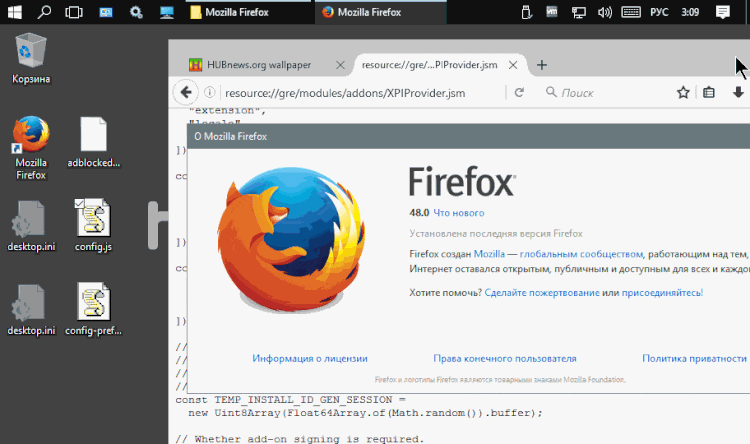
You can now install signed and unsigned extensions in Firefox Stable or Beta.
What happens
The code in the config.js file loads one of the config Firefox files and removes information from the "Signed_Types" constant in this file. This constant specifies the types of add-ons and extensions that must be signed for installation.
Some extensions, such as themes, do not need to be signed. Thus, the code clears the constant from all types of add-ons, so installing any of them does not require a signature.
The code in the second file tells Firefox to load the config.js file on startup.
It's strange that this is so easy, given that the mandatory signing of extensions is used to improve security.
Mozilla has been working on implementing WebExtensions support in Firefox for a long time, which will make this browser work with various extensions originally developed for Google Chrome and compatible browsers. In other words, the Chrome extension can be used in Firefox.
The company will launch the initial stable version of WebExtensions in Firefox 48 Stable, which is scheduled for release on August 2 this year. True, the developers warned that, although the result achieved is the first significant step towards the goal, full compatibility with Chrome extensions in new Firefox not worth the wait.
However, even in this form, WebExtensions will allow Firefox users to install many different Chrome extensions in the browser. And now we will tell you how this can be done.
So how to install chrome extension in Firefox?
To begin with, we note once again that Firefox 48 supports many different Chrome extensions, but not all and not at once. Again, all because the feature is in development (and, obviously, will not work with not1 for a long time), in addition Firefox browser does not support part of the functionality of some extensions that Chrome supports.
Now, actually, to the point:
- installing the Chrome Store Foxified add-on
First of all, install a special add-on Chrome Store Foxified (CSF), which will be responsible for the conversion and installation of extensions. Link to the page in the official catalog Mozilla add-ons – Here . After installing this addon in the Chrome extension store, when you open it through Firefox, it will automatically change the standard button on the page of the selected extension “ Install " on " Add to Firefox” (ADD TO FIREFOX).
- installing chrome extensions in firefox
We go to the section " Extensions "Chrome Web Store, select the desired extension and click the" Add to Firefox “. Further, depending on the settings you just installed Firefox add-ons, the extension will either be installed automatically or you will install it manually. CSF can also install Chrome extensions in Firefox in the form of temporary add-ons for the duration of one browser session. Simply put, after closing the browser, such temporary installed extensions-Addons will be automatically removed.
The option is not quite familiar, but quite useful. For example, in the case when you just need to see how this or that Chrome extension will work in your Firefox. It will also come in handy if you have problems loading the extension due to the need for pre-authorization via account Mozilla.
After you press the " Add to Firefox” A notification line will appear at the top of the screen with two buttons like this:
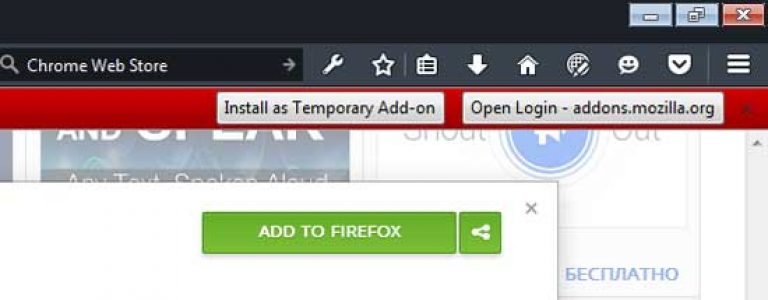
The first one provides for temporary use of the extension after installation, the second one for permanent use, but only after authorization through a Mozilla account. Chrome Store Foxified add-ons can be configured to automatically choose to temporarily install Chrome extensions. For this, in Settings "Firefox select section" Add-ons “, in the list of extensions we find Chrome Store Foxified , press the button “ Settings ” next to the name of the program, scroll down the window and check the box “ Do not sign “.
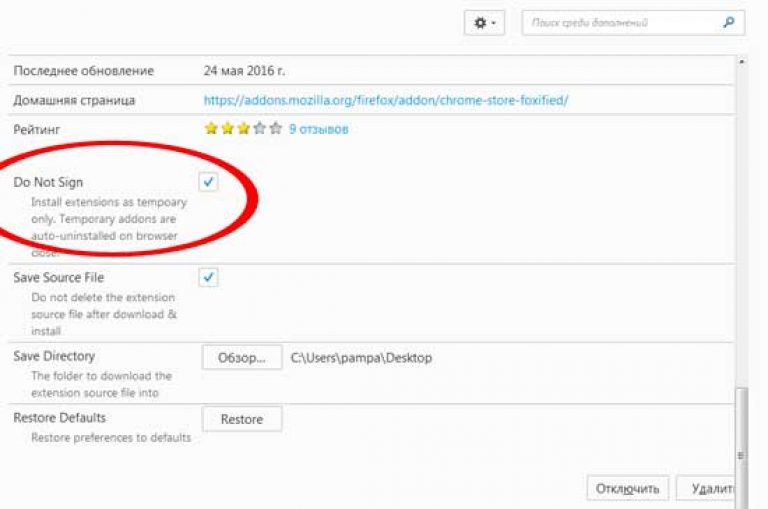
How Chrome Extensions are Installed in the Firefox Browser
The CSF addon loads the selected Chrome extension and converts it from the format crx (Google's standard format for extensions) to the format xpi (standard Mozilla format), making the necessary changes to the file manifest.json and adapting it to Firefox settings, and then saves the processed file on your PC desktop or in any other location that you specify in the addon settings.
Browser extensions, including Firefox, are very popular among users. With their help, the web browser receives additional functionality customized for specific needs.
Instruction
In the window that appears, select the "Get add-ons" tab. On the page that opens, you can select extensions from the "Recommended" and "Growing in popularity" sections.
The Mozilla Firefox browser has long won the hearts of many users around the world, and the almost endless extensibility of the program through add-ons played a significant role in this. If you want a tool to block malicious sites - please! You need to transfer your bookmarks and passwords to another computer in a few seconds - there is nothing easier! For those who are not yet in the know, I will explain that add-ons (extensions) are tiny programs that change or expand the functionality of your Mozilla Firefox, allowing it to acquire the features you personally need. About how and what add-ons it is desirable to settle in your browser and will be discussed in our article.
Mozilla Firefox add-ons, like any other extensions for any other programs, I strongly recommend downloading only from the official site: https://addons.mozilla.org/en/firefox/
By visiting the above site, on the left you will see a list of categories into which add-ons for Mozilla Firefox are divided, and on home page extensions recommended by the developers. It's easy to get lost in this variety, so let's imagine that we are ordinary ordinary users and find Mozilla Firefox for ourselves a few useful additions. But first, we will figure out how to add extensions to the browser.
How to install add-ons in Mozilla Firefox?
To find and install the desired add-on for Mozilla Firefox, you can go to the site and enter the name of the extension you need in the "Search for add-ons" field. If you do not know what it is called and just want to install something useful, then select the category you are interested in from the list of categories on the left. After reviewing several dozen additions, you will find what you want.
Carefully read the description of the add-on and, making sure that it is exactly what you need, click the "Add to Firefox" button.
Mozilla Firefox add-ons usually download and install within seconds. The download speed depends on the size of the add-on and your internet speed. After Mozilla installations Firefox will ask you to restart your browser. Click the appropriate button.
That's all! Add-on installed. You can find it through the menu "Tools" - "Add-ons" - "Extensions".
In the same window there is a "Search for Add-ons" section, which allows you to find and add the necessary extensions to Mozilla Firefox without visiting any sites. To do this, simply enter the name of the add-on you are interested in in the search field and click the button with a magnifying glass.
Mozilla Firefox will issue a complete list of extensions suitable for your request and specifically for your version of the browser. Select the add-on you need from this list and click "Add to Firefox".
Further steps for installing add-ons are no different from those discussed earlier.
Sometimes it turns out that you have already downloaded the extension for Mozilla Firefox in the form of a file saved somewhere on the disk. To install it, select "Open File" from the "File" menu of your browser.
Find the saved add-on for Mozilla Firefox on the disk (usually such files have the extension .xpi), select it and click the "Open" button. You will have to go through the already familiar extension installation procedure that we covered earlier.
As you can see, installing add-ons for Mozilla Firefox is not difficult. And now we will get acquainted with some useful extensions. We hope they will make your work in Mozilla Firefox more convenient.
Useful extensions for Mozilla Firefox
FEBE
The first place in our ranking will rightfully take FEBE - Firefox Environment Backup Extension, a backup tool for all your settings and Mozilla extensions Firefox. In a few seconds, you can save bookmarks, passwords, history, themes and all installed extensions, including FEBE itself, in a separate folder. They will not be lost or erased, because when reinstalling Mozilla Firefox or working on a different computer, you can quickly restore your usual add-ons and all your data.
At the time of writing, FEBE could be downloaded from this page: https://addons.mozilla.org/en/firefox/addon/2109
After installing FEBE, the corresponding item "FEBE" will appear in the "Tools" menu of your Mozilla Firefox. Click "FEBE Settings" to define the basic options for creating and storing backups.
In the FEBE settings window, you can choose which items to include in backup(section "Settings"), in which folder to save it (section "Directory") or configure the creation of a scheduled backup (section "Scheduler").
To create a backup with all the objects selected in the FEBE settings, click "Create backup". FEBE will save all your extensions, history, passwords, etc. in a separate folder. You can restore them at any time by selecting "Tools" - "FEBE" - "Restore" from the menu. Moreover, FEBE does not restore everything at once, namely the objects you marked.
Now you will be calm about your data and easily transfer it to Mozilla Firefox on any computer.
NoScript
Currently, the security situation on the Internet is more than tense - malicious programs are placed not only on sites with "strawberries" and cracks, but also on respectable portals hacked by hackers specifically for these purposes. In most cases loading malware on the computer of unsuspecting users happens with the help of scripts.
Script or script is the usual programming code, hosted on a web page, which allows you to perform some action. For example, register Mailbox, chat on forums or browse the pages of the site using a beautiful animated menu. But there are also malicious scripts that download viruses, trojans and other software harmful to your computer onto your PC.
Therefore, to avoid such infection when visiting sites, you need to disable scripts for untrusted sites. You can do this both in the settings of Mozilla Firefox itself (menu "Tools" - "Settings" - "Content" - "Use JavaScript"), and using the NoScript add-on. At the time of writing, it was available at:
After installing NoScript, an "S" icon will appear in the lower right corner of your Mozilla Firefox. And by right-clicking on any web page, you can allow it to execute all or certain scripts, or disable scripts altogether.
The addresses of all sites with allowed scripts are entered into a special list, which is available in the "Settings" - "White List" item of the same context menu. You can easily edit it by removing or adding the site addresses you need.
There are many options in the NoScript settings that can make your browsing experience more secure even with default settings. On the other hand, you won't be able to normally view sites with a lot of scripts without setting up NoScript, some menus may not open, videos and flash may not be shown. To see the blocked elements, right-click on the page and in context menu select "NoScript" - "Temporarily allow on this page". Thus, you will allow the execution of most scripts, but until you refresh the page. Of course, NoScript is a bit of a maniacal way of protection, but nevertheless, it works and will protect you by 95% from malicious programs that are loaded using scripts.
Adblock Plus
Oh that ad! Not only is she on TV every 10-20 minutes, she also settled on the Internet. If you are terribly uncomfortable looking at ads, your choice is Adblock Plus. This extension for Mozilla Firefox is designed to save your nerves and good mood by blocking your chosen advertising images.
At the time of this writing, you could add Adblock Plus to Mozilla Firefox from here: https://addons.mozilla.org/en/firefox/addon/1865
After installation, you will be prompted to add a subscription to filter lists for common banner ads that will be blocked by Adblock Plus. Select a subscription for Russia and click "Subscribe".
Now, when you visit a site with ads that are in the filter list, Adblock Plus will automatically block them without your participation. To block the disturbing advertising banner right-click on it yourself and select "Adblock Plus: block image".
You will see a window with blocking options. Click "Add filter" and blocked ads won't bother you anymore. To view and edit existing filters, click the "Show existing filters" button in the same window.
DownThemAll!
DownThemAll extension! is a great alternative to download programs (download managers). You can download images from web pages, multiple files at the same time, queue them up and view download details.
Install DownThemAll! you can from here: https://addons.mozilla.org/ru/firefox/addon/201
To add a link to a file to the queue, right-click on it and select "Save link with DownThemAll!". A window with download options will open in front of you.
Select a directory to save the file in the "Save files in:" field and click "Start!" to download the file immediately or "Queue" to add the file to the download queue.
After adding five or two files to the queue, select them and click "Start" to start downloading.
fireftp
We have already written about what FTP is and how to work with it using some programs: http://www.yachaynik.ru/content/view/48/31/. Mozilla Firefox also has a very handy, small and nimble add-on for working with FTP servers. It is called FireFTP and is available on this page: https://addons.mozilla.org/en/firefox/addon/684
Thanks to FireFTP, you can upload and download files from FTP servers without leaving your favorite browser window. Launch FireFTP through the "Tools" menu.
The contents of your computer will be displayed on the left side of the window. Choose desired disk, folder, file, you can use the mouse or the "Browse" button.
To connect to an FTP server, it must be added to the list by clicking "Create an account" in the upper left corner of the browser. Enter the server name in the "Account Name" and "Host" fields, the login and password of the user for accessing FTP in the "Login" and "Password" fields, respectively. Click OK.
To connect to an FTP server, select it from the list and click Connect. On the right side of the window, you will see the contents of the server. You can move files and folders between the server and your computer by simply dragging and dropping the mouse.
Disconnecting from the FTP server is also easy - click the "Disconnect" button in the upper left corner of the window.
Like any self-respecting FTP manager, FireFTP provides the ability to manage access rights to files and folders on an FTP server. To do this, right-click on desired file or folder and select "Properties". In the window that appears, you can set the access rights you need.
FireFTP can also rename, delete, create files and folders, which makes it a worthy alternative regular programs to work with FTP.
How to remove an extension in Mozilla Firefox
Our story would be incomplete without instructions on how to remove add-ons for Mozilla Firefox. Everything here is outrageously simple: open the "Tools" menu and select "Add-ons" - "Extensions". Highlight the browser extension to be removed and click Remove. Then restart Mozilla Firefox.
You can do it not so radically, because the selected addition may still be useful to you. Just disable it by clicking the "Disable" button. The extension will cease to function, but will remain in Mozilla Firefox. At any time, you can wake it up from sleep by highlighting it in the list and clicking "Enable".
This concludes our discussion of extensions for Mozilla Firefox. As you understand, a huge number of them have been created for all occasions and for various needs. Download, install and make your Mozilla Firefox unique and as functional as possible!
Many users did not like this innovation, including me. For example, I use several old, but still quite working add-ons, the development of which was discontinued many years ago. And I myself modify some additions to fit my needs, of course, after such changes, the digital signature becomes invalid. Fortunately, the developers then left a parameter in the browser settings that allows you to disable the check digital signatures installed add-ons.
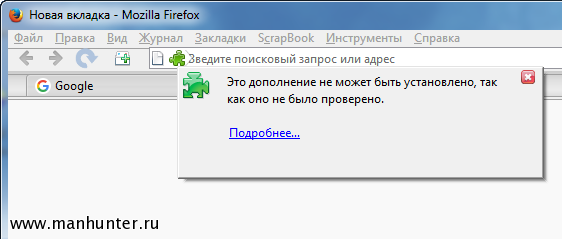
Starting with version 48, the freebie was covered, Firefox stopped accepting this parameter. Regardless of its value, if you try to install any unsigned extension, you will see a warning about the danger, and the installation will be blocked. But there is a way by which you can still install third-party extensions in the Firefox browser.

First you need to switch Firefox updates to the ESR (Extended Support Release) channel. This is an extended support version of the browser designed for use in organizations. Installed directly on top of the current versions of Firefox, all settings remain in place, nothing flies.
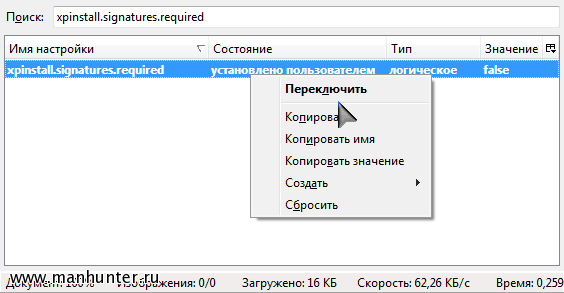
Now go to the settings page by typing in the address bar about:config. There we find the parameter xpinstall.signatures.required and double-click to switch its value to false. That's all, now you can install any updates without any problems, including unsigned or modified ones. Another idiotic quirk from Firefox's "effective managers" has been successfully overcome.




